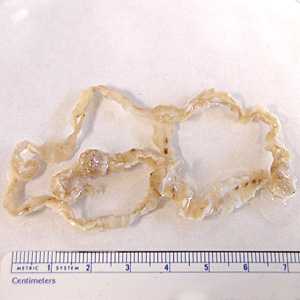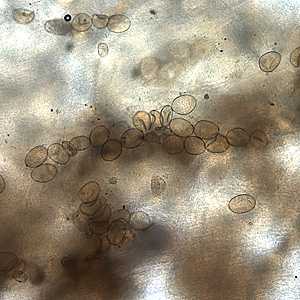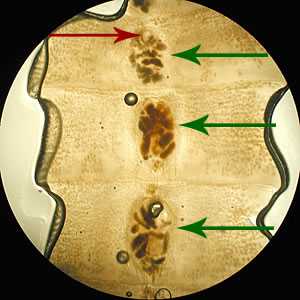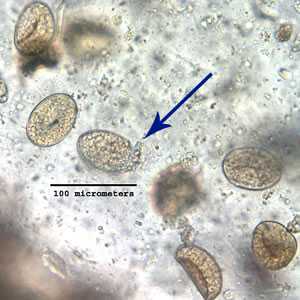
Case #172 - January 2006

Figure A

Figure B

Figure C

Figure D

Figure E

Figure F
Case Answer
This was a case of diphyllobothriasis, caused by a cestode in the genus, Diphyllobothrium. Diagnostic morphologic features included:
- a stroblia consisting of proglottids that were broader than they were long.
- centrally located genital pores (Figure C, red arrow) and rosette-shaped uteri (Figure C, green arrows). These features ruled-out Taenia sp.
- operculated eggs (Figure F, blue arrow) within the size range for Diphyllobothrium spp.

Figure C

Figure F
DNA was extracted from a few proglottids and a fragment of approximately 2100 base pairs was amplified by PCR from the Diphyllobothrium 18S rRNA gene. DNA sequencing analysis was performed on the amplified fragment, and the sequence showed 99% similarity with Diphyllobothrium latum 18S rRNA sequence deposited in GenBank under accession number DQ316793.
More on: Diphyllobothriasis
This case was kindly contributed by the Florida Department of Health.
Images presented in the monthly case studies are from specimens submitted for diagnosis or archiving. On rare occasions, clinical histories given may be partly fictitious.
DPDx is an education resource designed for health professionals and laboratory scientists. For an overview including prevention and control visit www.cdc.gov/parasites/.
- Page last reviewed: August 24, 2016
- Page last updated: August 24, 2016
- Content source:
- Global Health – Division of Parasitic Diseases and Malaria
- Notice: Linking to a non-federal site does not constitute an endorsement by HHS, CDC or any of its employees of the sponsors or the information and products presented on the site.
- Maintained By:


 ShareCompartir
ShareCompartir